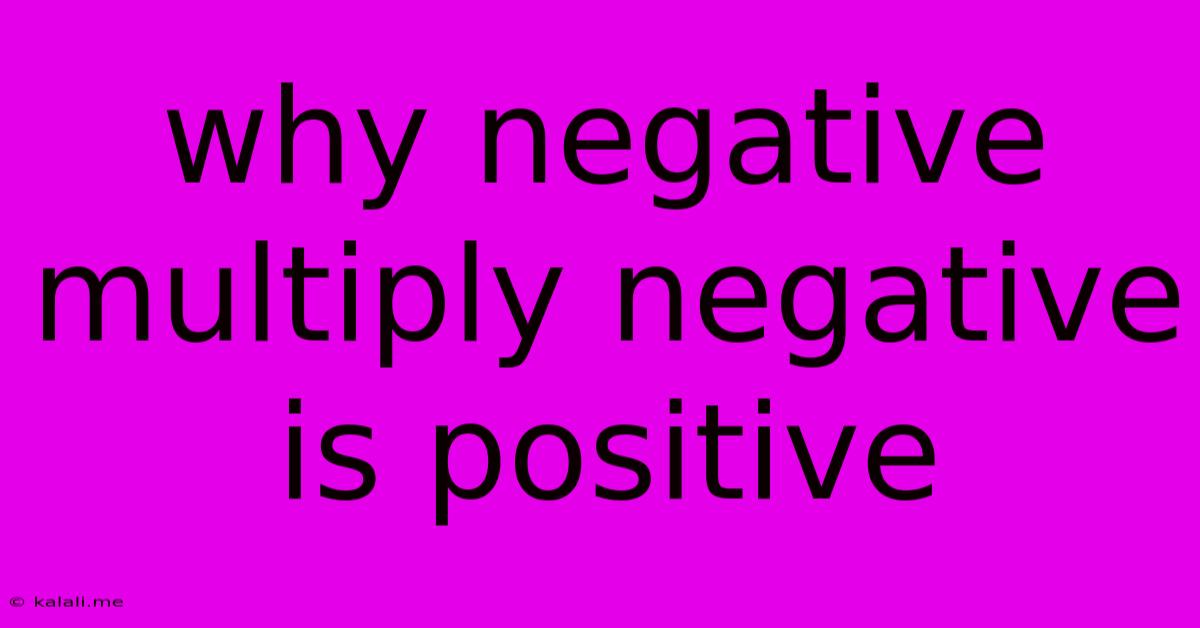Why Negative Multiply Negative Is Positive
Kalali
Jun 06, 2025 · 3 min read

Table of Contents
Why Negative Times Negative Equals Positive: Unveiling the Mystery
Understanding why a negative number multiplied by another negative number results in a positive number can be tricky. It's not immediately intuitive like adding or subtracting negative numbers. This article will explore several approaches to explain this fundamental mathematical concept, demystifying this often-confusing rule. This explanation will use real-world examples and logical reasoning to make the concept clear and memorable.
The Mathematical Proof: Using the Distributive Property
One of the most convincing ways to demonstrate this is through the distributive property of multiplication over addition. Let's consider the following equation:
-1 * (a - b) = -a + b
This equation states that multiplying -1 by the difference between 'a' and 'b' is the same as subtracting 'a' and adding 'b'. Now, let's substitute values:
-1 * (5 - 3) = -1 * 2 = -2
And applying the distributive property:
-1 * (5 - 3) = (-1 * 5) + (-1 * -3) = -5 + (-1 * -3)
For the equation to hold true, -5 + (-1 * -3) must equal -2. Therefore, (-1 * -3) must equal 3. This demonstrates that a negative number multiplied by another negative number results in a positive product.
Visualizing with Number Lines and Vectors
Imagine a number line. Multiplication can be visualized as repeated addition or subtraction. A positive number multiplied by a positive number means repeated addition in the positive direction. A negative number multiplied by a positive number represents repeated addition in the negative direction.
Now consider a negative number multiplied by a negative number. This can be interpreted as reversing the direction of repeated subtraction. Subtracting a negative number is the same as adding a positive number. Reversing the direction of this action (multiplying by -1 again) brings us back to the positive side of the number line. This can be extended to understand vector multiplication as well, where the reversal of direction is more apparent.
Real-World Analogy: Debt and Cancellation
Let's use a practical example. Imagine owing someone $5 (represented as -5). If you were to take away (subtract) three of those $5 debts (-3), you are essentially cancelling three debts. This cancellation leads to an improvement in your financial situation, meaning you now have a positive amount, which in this case would be +15. This illustrates the concept of a negative multiplied by a negative resulting in a positive.
Patterns and Consistency in Mathematics
Another important reason for accepting the rule of negative times negative equals positive is the consistency it brings to the entire mathematical system. This rule ensures that the laws of arithmetic remain consistent and predictable, allowing for complex calculations and applications across various fields such as physics, engineering, and finance. Without this rule, many mathematical operations would be inconsistent and unreliable.
Conclusion
The concept of a negative number multiplied by a negative number yielding a positive result might seem counterintuitive at first. However, through various approaches such as the distributive property, number line visualization, real-world analogies, and the need for consistency within the mathematical system, we can understand and appreciate the logic behind this fundamental rule. This knowledge is essential for a comprehensive understanding of mathematics and its applications.
Latest Posts
Latest Posts
-
Why Is My Car Jerking When I Drive
Jun 07, 2025
-
Bible Verse A Cord Of Three Strands
Jun 07, 2025
-
Light Switch And Outlet Wiring Diagram
Jun 07, 2025
-
How To Delete Text On Android
Jun 07, 2025
-
Its Gonna Be On You Meaning
Jun 07, 2025
Related Post
Thank you for visiting our website which covers about Why Negative Multiply Negative Is Positive . We hope the information provided has been useful to you. Feel free to contact us if you have any questions or need further assistance. See you next time and don't miss to bookmark.